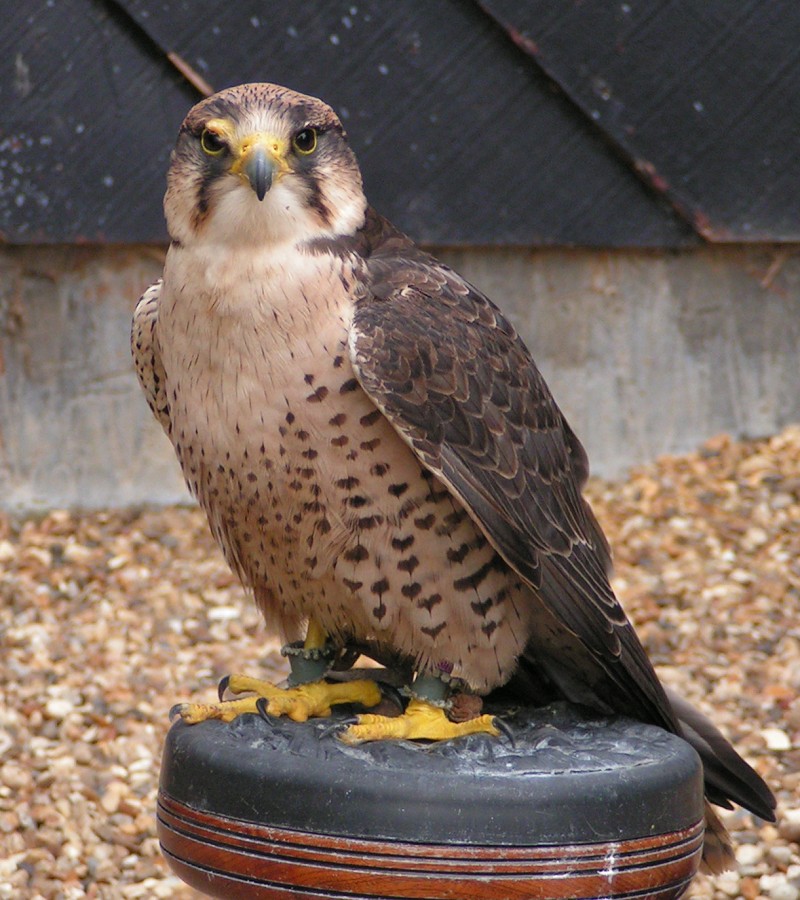| 새로운 사진 | 신문속의 동물소식 | 신기한 동물이야기 | 동물의 소리 | 동물동화상 | 사진 올리기 | 사진 저작권 | English |
|---|
| 재미있는 동물사진 | 괴수/괴어/엽기 동물사진 | 동물이름사전 | 동물목록 | 바깥고리 | 창고입구 | 똑똑누리집 |
|---|
| 이미지 정보 | Original File Name: European Lanner Falcon (Falco biarmicus feldeggi)_800.jpg Resolution: 800x900 File Size: 180900 Bytes Upload Time: 2007:12:06 16:11:09 | |
| 올린이 | 이름 (메일주소): Unknown | |
| 사진 제목 | Lanner Falcon (Falco biarmicus) - Wiki | |
 |
| Email : 카드 | 올린이 | 운영자 사진삭제 정보수정 Admin |
| 설명 | Lanner Falcon (Falco biarmicus) - Wiki
Lanner Falcon
The Lanner Falcon (Falco biarmicus) is a large bird of prey that breeds in Africa, southeast Europe and just into Asia. It is mainly resident, but some birds disperse more widely after the breeding season. It is a large falcon, at 43-50cm length with a wingspan of 95-105cm. European Lanner Falcons (Falco biarmicus feldeggi, also called Feldegg's Falcon) have slate grey or brown-grey upperparts; most African subspecies are a paler blue grey above. The breast is streaked in northern birds, resembling greyish Saker Falcons, but the Lanner has a reddish back to the head. Sexes are similar, but the browner young birds resemble Saker Falcons even more. However, Sakers have a lighter top of the head and less clear head-side patterns. The Lanner's call is a harsh "wray-e". The Lanner Falcon is a bird of open country and savanna. It usually hunts by horizontal pursuit, rather than the Peregrine's stoop from a height, and takes mainly bird prey in flight. It lays 3-4 eggs on a cliff ledge nest, or occasionally in an old stick nest in a tree. This is presumably the oldest living hierofalcon species. Support for this assumption comes mainly from biogeography agreeing better with the confusing pattern of DNA sequence data in this case than in others. Nonetheless, there is rampant hybridization (see also Perilanner) and incomplete lineage sorting which confounds the data to a massive extent; molecular studies with small sample sizes can simply not be expected to yield reliable conclusions in the entire hierofalcon group. In any case, the radiation of the entire living diversity of hierofalcons seems to have taken place in the Eemian interglacial at the start of the Late Pleistocene, a mere 130,000-115,000 years ago; the Lanner Falcons would thus represent the lineage that became isolated in sub-Saharan Africa at some time during the Riss glaciation (200,000 to 130,000 years ago) already. Lanner Falcon males are called lannerets in falconry, where the species is sometimes used as a 'first falcon' by less-experienced falconers. Displaying a good nature sometimes lacking in more highly powered birds, what Lanners lack in hunting prowess they more than make up for in personality. Outstandingly maneuverable, they use their large tails and relatively low wing loading to perform exceptionally to the lure and can take a range of small birds as prey. One of the few raptors to attack prey head on at times, their tactics of ambush and surprise make them entertaining birds for crowds to enjoy. They are bred in captivity for falconry; hybrids with the Peregrine Falcon ("perilanners") are also often seen. Merret (1666) claimed that the "lanar" lived in Sherwood Forest and the Forest of Dean in England; such populations would seem to derive from escaped hunting birds of the nobility. In the wild Lanner Falcon numbers are somewhat declining in Europe, though the species remains relatively common in parts of Africa. http://en.wikipedia.org/wiki/Lanner_Falcon
| |||
| 저작권 정보 | 사진의 저작권은 원저작자에게 있습니다. 동물그림창고는 동물관련 사진을 전시할 수 있는 공간만을 제공합니다.사진을 사용하고자 할 경우에는 저작권자와 협의하시기 바랍니다. |
|
|
|
| |||||||
| CopyLeft © since 1995, 동물그림창고. All rights may be reserved. | ||||||||
Stats